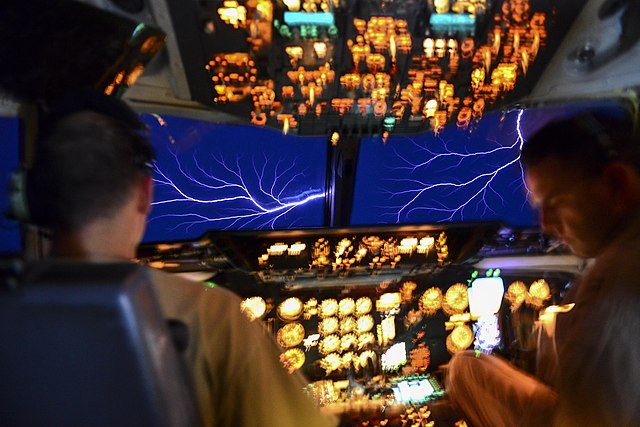
What is St. Elmo’s fire? It is a glowing region that appears around tall structures, the masts of old ships, or the wings of aircraft. It is a plasma made by a corona discharge from the structure. St. Elmo’s fire looks like a blue or violet fire that has engulfed the tip of whatever structure it is on. It appears during thunderstorms because it needs a difference in electrical charge between the structure and the sky.
What causes St. Elmo’s fire? It is a plasma, which is the fourth state of matter. The other three are solid, liquid, and gas. A plasma is superheated matter. The four states of matter occur when different amounts of energy are applied to the atoms. The more energy that is applied to an atom, the more it vibrates and moves around. The solid state has the least energy and the atoms don’t move much. The liquid state is next and the atoms move just enough that they can flow around, but not enough that they can fly away. The gas state is next and the atoms have so much energy that they can fly away from each other and take up a huge amount of space. Plasma is the last state and the atoms have so much energy that they move with incredible speed. They collide with each other with such force that the electrons are ripped away from them. The positively charged atoms and the negatively charged electrons fly around, forming the plasma.
You need four things to make St. Elmo’s fire. You need an electrical difference between the air and the sky. You need a, usually high up, object that has a charge. You need the object to be pointy. And you need air.
During a thunderstorm there is a large electrical difference between the clouds and the ground. In a thunderstorm, tiny water droplets swirl around in the clouds. These water droplets collide with each other and create a static electric charge. This electrical difference between the clouds and the ground affects the air molecules between them. The electrons around each atom start to move farther away from the nuclei of each atom, which makes them more conductive to electricity. Lightning can occur in this situation because the static electric charge in the clouds can easily travel through the atoms in the air to equalize with the ground. When the atoms in the air have picked up enough energy and the electrons have moved far enough away from the nuclei, they are ionized and have become a plasma. This is the first part of St. Elmo’s fire.
Secondly, they need a charged object to connect to. St. Elmo’s fire happens when the electrons that are floating around the atoms in the air are stripped away, leaving behind the charged ions. The electrical difference between the clouds and the ground has made the electrons around the nuclei in the air orbit far away. When these atoms become concentrated around a charged object, the negatively charged electrons are attracted to that object and removed from the atoms in the air, leaving ions and a plasma. The wings of planes are a perfect example. The masts of old ships are another source of St. Elmo’s fire. You might think that a wooden mast wouldn’t hold a charge, but the tips of the mast usually had metal spars and they were wet. Modern ships, conversely, don’t get St. Elmo’s fire because the whole ship is metal and all parts of the ship are grounded to the Earth.
Thirdly, the object needs to be pointy. The charge can build up anywhere in the sky, but pointy objects concentrate the atoms into a smaller area and strip more electrons from the atoms, creating the plasma.
And lastly, you need air. The electrons that are flying to the point of the building knock into other neutral particles and excite them by giving them energy. All particles don’t want extra energy and they try to lose it as quickly as possible. When they lose it, they give off the energy as a photon of light. The oxygen and the nitrogen molecules in the air give off a photon that has a wavelength within the blue spectrum of light. This is called a corona discharge.
St. Elmo’s fire is usually a sign that lightning is imminent, which is very dangerous on the seas. It is less dangerous to a plane because they are designed to deal with it. You can see the process behind St. Elmo’s fire in action whenever you switch on a fluorescent light.
Why is it called St. Elmo’s fire? It is named Saint Erasmus of Formia, known as St. Elmo, who is the patron saint of sailors. It was considered a good omen because it warned sailors of the likelihood of a lightning strike. And this is what I learned today.
Image By Senior Airman Brian KellyVIRIN: 170322-F-ZZ999-002E.JPG – https://www.defense.gov/observe/photo-gallery/igphoto/2001813286/, Public Domain, https://commons.wikimedia.org/w/index.php?curid=89116568
Sources
https://www.dictionary.com/browse/saint-elmo-s-fire
https://en.wikipedia.org/wiki/St._Elmo%27s_fire
https://en.wikipedia.org/wiki/Erasmus_of_Formia
https://science.howstuffworks.com/nature/climate-weather/atmospheric/st-elmo-fire.htm
https://www.livescience.com/st-elmos-fire.html
https://skybrary.aero/articles/st-elmos-fire
https://www.psfc.mit.edu/vision/what_is_plasma
https://scied.ucar.edu/learning-zone/sun-space-weather/plasma
https://ktvl.com/news/local/ever-wonder-how-lightning-forms-news-10-meteorologist-breaks-it-down
https://forums.spacebattles.com/threads/st-elmos-fire-on-modern-warships-or-commercial-ships.863840/
